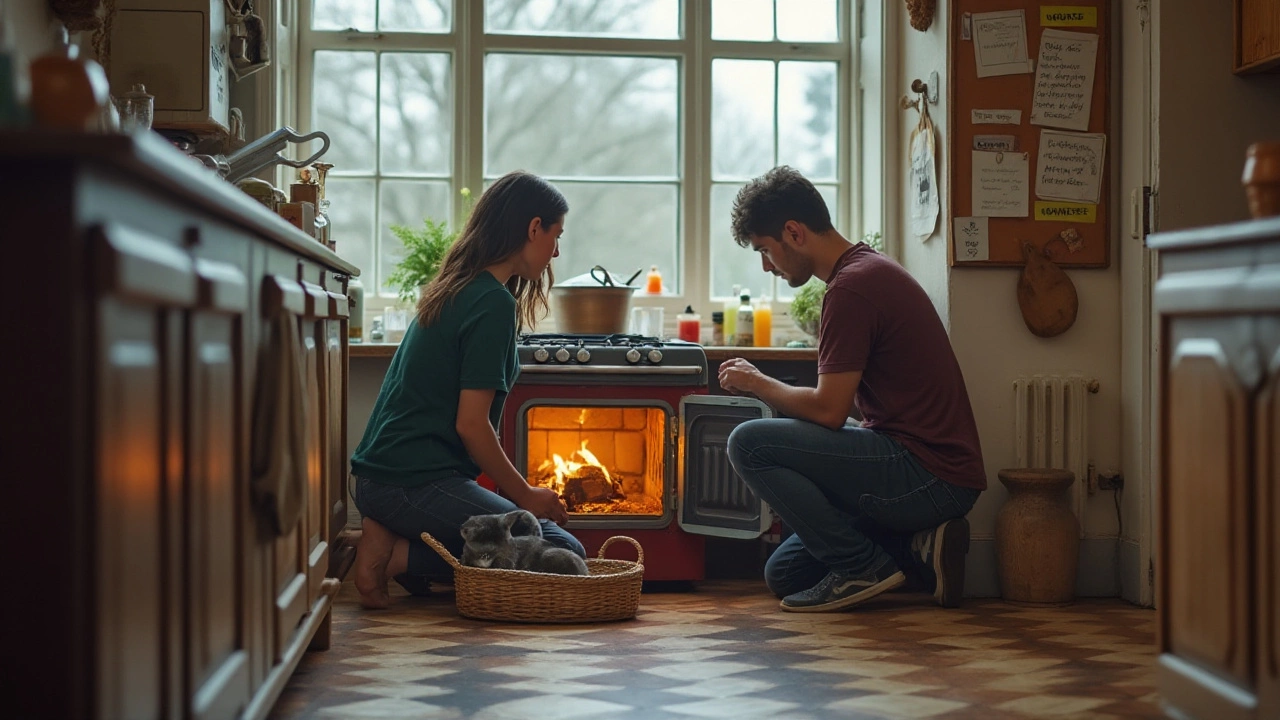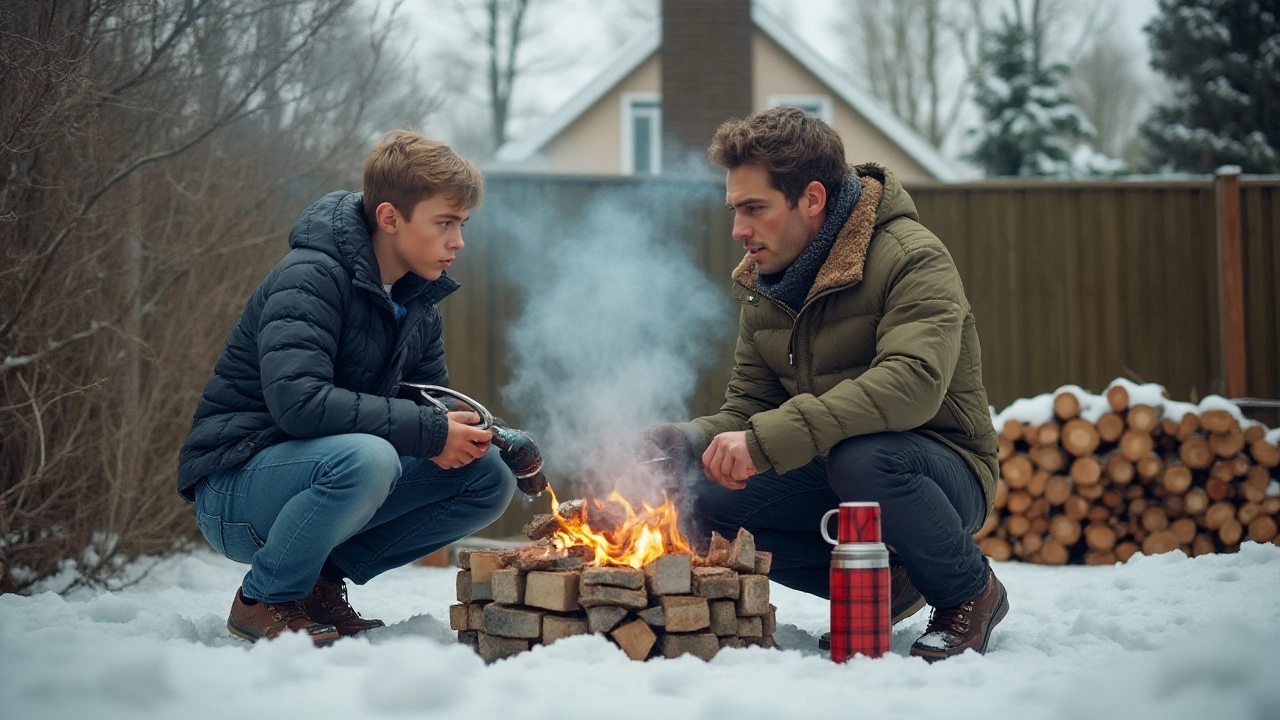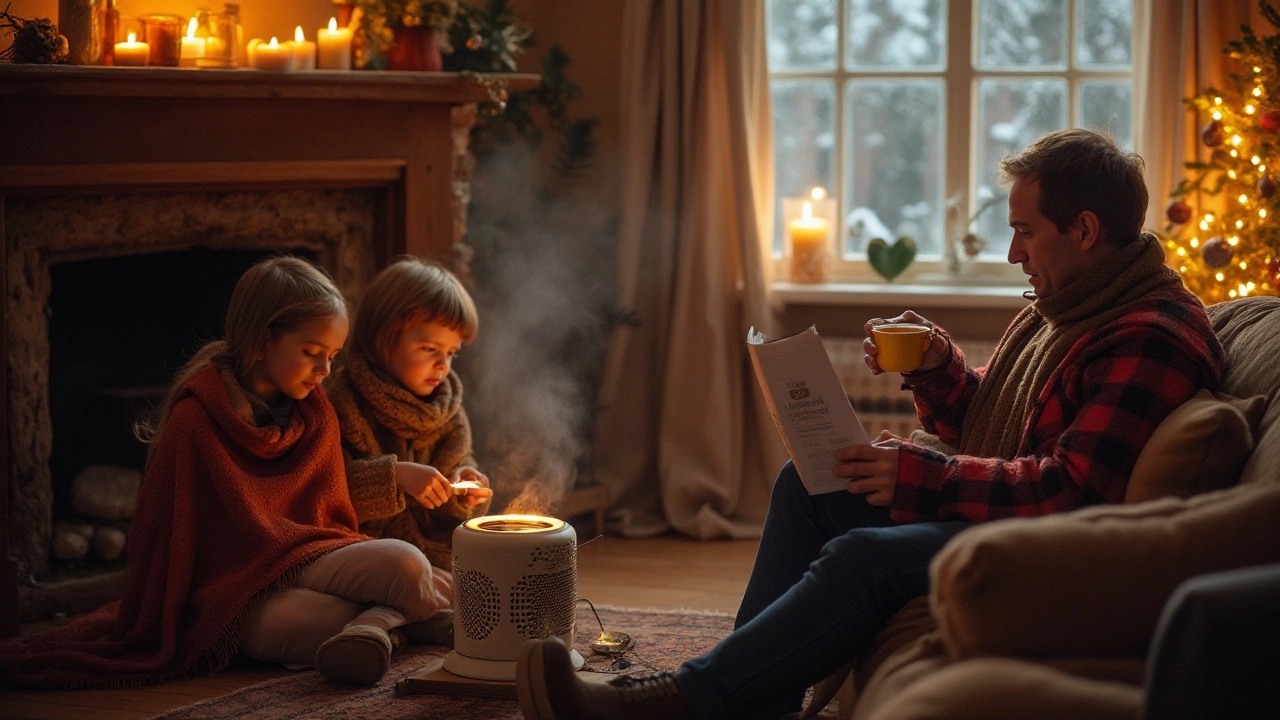Winter can be a challenging time to face a broken boiler, but it's not the end of the world. There are numerous ways to stay warm without relying on your primary heating system. Whether it's a short-term break or a longer repair scenario, using a combination of strategies can provide you with much-needed relief until the boiler is fixed.
In this article, we'll explore various methods to heat your home and keep your family comfortable. From understanding where heat escapes to finding simple yet effective alternative heating solutions, there are ways to tackle the cold head-on. Knowing preparation strategies and safety tips ensures you and your loved ones can handle the situation safely.
- Understanding Heat Loss
- Alternative Heating Solutions
- Making the Most of Existing Heat
- Emergency Preparedness
- Safety Tips to Keep in Mind
Understanding Heat Loss
Understanding heat loss is crucial when your home heating system becomes unpredictable. Heat loss occurs because warm air wants to move towards cooler areas, due to the basic laws of thermodynamics. During colder months, this natural tendency can be a homeowner's nightmare. The key to maintaining warmth is identifying how and where heat escapes and ensuring insulation is up to par. Start with the largest culprits—walls, roofs, and windows. These areas contribute significantly to escaping warmth. You might be surprised to learn that up to 25% of heat is lost through poorly insulated walls. Double-glazing windows and draft-proofing can significantly cut down on heat loss, preserving more of that precious indoor warmth.
Another major player in heat loss is the floor. In many older homes, particularly those without modern insulation, a substantial amount of warmth can seep out. Ensuring carpets or adding rugs can create an additional layer of insulation. Radiators, too, should be free of obstruction. Though often overlooked, ensuring that no furniture blocks the radiator allows for maximum heat circulation. One effective way to reduce heat loss is to place reflective radiator panels behind them. These panels, usually made from aluminum foil, reflect the warmth back into the room instead of letting it escape through the walls.
Ventilation is essential for air quality but can be a cause of heat escape. The trick is striking the right balance between letting fresh air in and not allowing warm air to flee too readily. Cracks and gaps around eaves, skirting boards, and sockets need sealing to prevent cold drafts from stealing the indoor warmth. It’s these small openings that collectively result in significant warmth escape. Another strategic move involves recognizing and using natural light. During daylight, keep curtains open to let warmth in and close them once the sun sets to act as another insulation layer.
Diving into Heat Retention
Retaining heat isn't just about eliminating loss; it's about maintaining efficient home dynamics. Did you know the color of your walls can affect warmth retention? Dark colors absorb more heat than lighter shades, making them suitable for maximizing warmth in sun-facing rooms. Carpeting and drapery also play a role, as they add layers of thermal resistance. A thicker curtain can act as an extra wall of protection against heat loss through windows.
Technology offers new ways to handle heat more efficiently. Smart thermostats that adjust according to your schedule help maintain an efficient temperature. Closing off unused rooms concentrates warmth where it's needed most. House plants can help regulate temperatures, acting as natural humidifiers. A properly humid environment feels warmer than a dry one, allowing for lower thermostat settings while maintaining comfort.
Beyond these technical aspects, practical efforts play a part. An anecdote shared by the Energy Saving Trust emphasizes the importance of curtain use.
"Simply ensuring your curtains are closed at night can reduce heat loss by up to 17%," they explain, highlighting how small changes make significant differences.Combining these with the technological aids available, can help maintain an efficient, warm environment without relying solely on your boiler. Knowing how to limit heat loss is half the battle won, considerably shortening the duration you're left cold due to broken boiler episodes.
Alternative Heating Solutions
Finding yourself without a functioning boiler can be a daunting experience, but there are several effective ways to maintain warmth in your home. While the immediate response may be to reach for electric heaters, exploring a range of alternative heating methods can be more efficient and sometimes even more affordable. These solutions not only cater to different needs and spaces within your home but also emphasize the importance of adapting to the situation with both sustainability and ingenuity in mind.
Electric space heaters are often the first solution that comes to mind due to their portability and ease of use. These devices come in various types, such as convection, infrared, and fan heaters, each with their unique advantages. For instance, infrared heaters are highly efficient as they directly heat objects and people in the room rather than just the air. However, it's important to bear in mind their energy consumption, ensuring that their placement is optimal for both safety and efficiency.
According to the U.S. Department of Energy, "Portable heaters can be less costly to use if they are only heating a small space and you’re not heating rooms you aren’t using."
Besides electric options, consider using portable propane heaters which are ideal for emergency heating but require careful ventilation to avoid carbon monoxide buildup. These heaters can provide significant heat and are particularly useful during brief outages. Another viable option is utilizing kerosene heaters, known for their ability to deliver rapid warmth in larger spaces. However, similar to propane heaters, they demand proper safety precautions, including regular maintenance and ensuring that the area is well-ventilated.
If safety concerns with alternative fuels are paramount, radiant heating pads and blankets offer a personal warmth solution with low energy consumption. Designed to warm the body directly, these pads can effectively maintain a cozy temperature, especially when layered with traditional blankets or throws. This method is perfect for single occupants in smaller rooms, such as a home office or bedroom, where mobility is not a primary concern.
Wood-burning stoves or fireplaces can also serve as excellent heating alternatives if your home is equipped with them. These options tend to be eco-friendly when using seasoned wood and provide a charming, rustic atmosphere. It's crucial to ensure that chimneys and vents are clean and unblocked, preventing unwanted smoke or dangerous fumes from entering the living space. According to a survey by the American Wood Council, homes with functioning wood stoves experienced a noticeable decrease in heating bills during periods of boiler maintenance or failure.
Exploring creative methods such as thermal curtains and insulated window films can help in retaining the warmth emitted by these alternative sources. It's often surprising how much warmth escapes through windows and doors, so focusing on reducing heat loss can amplify the effectiveness of your temporary heating solutions. These adaptations can form part of a regular winterization routine, independent of any boiler-related issues.

Making the Most of Existing Heat
When your boiler decides to take an indefinite holiday, tapping into whatever warmth you already have becomes a high priority. Every home, even during a boiler breakdown, retains some heat that can be used to stave off the chill. Start by identifying where the warmth is still present. Areas like your kitchen, especially when cooking, or a room facing the sun can become small havens of heat.
One key strategy is to trap in warmth through insulation. Close doors to unused rooms and use draft excluders or rolled-up towels at the bottom of doors to keep heat from escaping. Heavy curtains can make a significant difference too. Close them at night to prevent heat loss through windows, and open them during daylight to let solar power do some work. Reflective panels placed behind radiators can also redirect heat back into rooms, a neat trick which costs surprisingly little.
Alternative heating tools such as portable electric heaters can help, but mind your energy bills. A cozy evening can be created by lighting candles, which not only provide warmth but can improve the ambiance and morale too. Consider adding rugs to bare floors, as they help in retaining heat in a room. Using layers upon layers is another efficient method; rely on heavy blankets and warm clothing. Undoubtedly, you’ve heard of the layering trick stood by mountaineers — the same principle applies in homes!
"There will be no need to suffer in chill. Gather together some strategies, and your warm home remains your haven," advises Eric Amsler, a veteran home heating consultant.
The ceiling fan too, believe it or not, can be a friend in disguise. During winter, set the fan to spin clockwise at a low speed, thus, gently pushing warm air back down into your living space. An oft-ignored ally, the humble hot water bottle, offers surprising comfort — use it under the blanket before hitting the sack. Pets, if you have them, can act as mobile heaters. They instinctively gravitate towards heat sources, and can keep your lap toasty warm.
A factor often overlooked during a broken boiler scenario is humidity. Using humidifiers adds moisture to the air, making it feel warmer. Remember though, when using such appliances, safety is king. Keep a fire extinguisher handy and ensure all your devices are in good shape. No warmth is worth risking your home’s safety over. So, it’s entirely possible to make the most of the existing heat even when the central heating is down, using simple mindfulness and methods that may have been sitting right under your nose all along.
Emergency Preparedness
When faced with a broken boiler, especially in the grips of a cold snap, emergency preparedness becomes a crucial lifeline. Preparing in advance can make all the difference in maintaining a comfortable and safe home environment until the home heating system is up and running again. To begin with, it’s wise to have an emergency kit specifically tailored for heating failures. This kit should contain essential items such as thermal blankets, space heaters, extra layers of warm clothing, and a reliable power source like battery-powered hand warmers. Having these items readily available can ensure you are not scrambling for resources during a time of stress.
In addition to physical preparations, one should cultivate an information repository that includes contact details for reliable heating technicians and a list of friends or family nearby who could provide shelter if needed. Gathering appliances like portable propane heaters is another consideration, but safety should always come first with these devices. If used incorrectly, they can pose risks of carbon monoxide poisoning. Therefore, ensure they are used in well-ventilated areas and never while sleeping. A carbon monoxide detector is a prudent investment for any home, especially in situations where alternative heating sources are used. As the saying goes, "An ounce of prevention is worth a pound of cure."
"Failing to prepare is preparing to fail," – Benjamin Franklin
Besides these preparations, sealing off rooms to retain warmth can strategically conserve heat. Use heavy drapes or blankets to cover doors and windows. Doors to unused rooms should remain closed to concentrate the heat in areas of high occupancy. Another key tactic involves implementing dietary changes. Consuming warm, calorie-dense foods and drinks like oatmeal, soups, and warm teas can help generate body heat from within. These simple yet often overlooked actions can notably impact your comfort level while awaiting boiler repair.
Technology can lend a helpful hand in planning for home heating emergency warmth. Apps that track weather forecasts help anticipate cold fronts, giving you adequate time to prepare. Some smart home devices can even automate the process of notifying you when the temperature dips to a certain threshold, prompting a quick check on thermal conditions. Lastly, it is wise to familiarize yourself with community resources. Churches, community centers, and local authorities sometimes offer warming shelter services during extreme weather events. Knowing where these are in advance can provide additional options should your home become uninhabitable due to equipment failure.

Safety Tips to Keep in Mind
Heating your home without the traditional use of a boiler can be a test of one's resourcefulness, but safety should always be the priority in the pursuit of warmth. Many alternative heating methods come with their own risks, which necessitates a cautious approach. First, ensure that any heaters you use are positioned away from flammable items such as curtains, furniture, or loose papers. Fireplaces and space heaters are very effective, yet they also pose significant risks if left unattended. Always double-check that your smoke and carbon monoxide detectors are operational, especially when relying on combustion-based systems like wood burners.
When using electric heaters, it's critical to prevent overheating and potential fires by not overloading power outlets and to avoid extension cords whenever possible. It’s advisable also to choose electric heaters with built-in shut-off features if they happen to tip over. Emergency warmth is vital, but it shouldn’t come at the cost of safety. An essential tip is to ensure that rooms are properly ventilated during use, especially in the case of kerosene or gas heaters. These devices can deplete oxygen quickly, causing dangerous air conditions. A cracked window can help maintain air quality.
Children and pets present additional considerations. Try to establish barriers around heaters to prevent accidental contact. Engaging younger family members in conversations about safety can also help, providing them with knowledge on why it’s important to not touch heating devices. In the words of the National Fire Protection Association, “Heaters are wonderful in keeping us warm in the winter, but they are also the second leading cause of home fires.”
“Safety doesn’t happen by accident.” – Author UnknownKeeping safety in mind, never leave heating sources unattended overnight or when leaving the house; it only takes one mistake for disaster to strike.
Importantly, always ensure there's a reliable way to call for help if needed; having charged phones is essential in an emergency. To emphasize, home heating situations call for prepared minds. A simple home safety plan that includes emergency contacts, safe exit routes, and a meeting point can be a lifesaver. These precautions, taking a proactive stance, not only ensure warmth but peace of mind.

